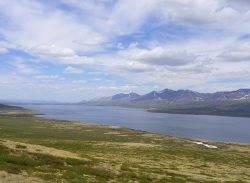
World Wetlands Day is celebrated annually on 2 February since 1997 to mark the anniversary of the signing of the Convention on Wetlands of International Importance in Ramsar*, Iran, in 1971. World Wetlands Day aims primarily at raising public awareness of wetland values and wise careful use of waterfowl habitat, as well as wetlands’ importance for the Earth’s ecosystem.
Ramsar Convention highlights the conservation and rational use of wetlands as a key to providing their sustained development worldwide. Wetlands are a nature resource of exceptional importance with close ecological ties with dozens of rare species of mammals, birds, amphibians. The Russian Federation hosts more than 2 million lakes covering a total area of over 370,000 sq km, and about 120,000 rivers running over 1.8 million kilometers.
Some 2,560 medium-sized and small lakes and about 1,200 lakes of glacial origin are located in the Altaiskiy Biosphere Reserve (BR). Swampy areas are found in inter-mountain depressions, river valleys and on smooth slopes.
The vast Dzhulukul inter-mountain depression – a unique wetland and one of the key hubs for the waterfowl and semi-aquatic birds in the Altai Republic – is located in the south of the BR. The depression is a unique cluster of South-Eastern Altai with tundra-steppe associations and a large number of high mountain lakes. It is a nesting, summer feeding and a transit rest ground for many bird species, with waterfowl and semi-aquatic birds among others, in the course of their nomadic migration. All reservoirs of the depression are located at the watershed of three river basins – the Ob, the Yenisei and the Kobdo (Mongolia).
The largest high mountain reservoir of the Altai Mountains and one of the headwaters of the Ob river – Lake Dzhulukul – is located in the depression. Reservoirs are nesting and moulting grounds for dabbling ducks, gulls and sandpipers. In summer large reservoirs (Dzhulukul, Upper and Lower Nepravil’noye) host a few thousand moulting ducks (predominantly a goldeneye (
Bucephala) and a red-headed bluebill (
Spermophaga ruficapilla)). Reservoirs rich in fish made this part of the Altai Mountains attractive to a great cormorant (
Phalacrocorax carbo) and a white-tailed eagle (
Haliaeetus albicilla). This place is also home to the great cormorant’s high mountain nesting colony - unique in the Altai Republic and Altai in general and the highest (by location) in Russia.
Some rare and endemic plants listed in the Red Data Book of the Russian Federation are found in the Dzhulukul depression, such as white locoweed (
Oxytropis), low alpine locoweed,
Rheum altaicum,
Aconitum paskoi and
Bupleurum martjanovii.
* hence the name – the Ramsar Convention
Information sources:
- Department of Science of the Altaiskiy Biosphere Reserve (from the report by O.B. Mitrofanov, a senior researcher of the Altaiskiy Reserve and an ornithologist, with the assistance of S.V. Chukhontseva, Deputy Director for Science
-
http://ru.wikipedia.org
-
http://ex-situ.ru/bibliographylist/32-book2.html
Photo by Sergey Ivoilov. Lake Dzhulukul